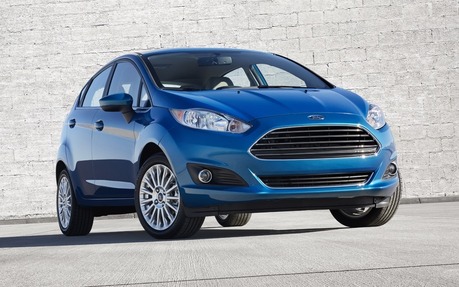2014 Ford Fiesta 1.0-litre: A three-cylinder turbo!
Los Angeles, California – The 2014 Ford Fiesta will be offered in North America with a new 1.0-litre three-cylinder EcoBoost turbo gas engine beginning in the spring of 2013. This engine, which is already found in 30% of the Fiestas sold in diesel-dominated Europe, is the alternative that Ford is proposing for drivers who aren’t crazy about diesel or hybrid cars. According to the manufacturer, its fuel consumption should come in at more than 40 miles to the gallon (that’s better than 5.88 litres per 100 kilometres), and although we’re still waiting for the official Environmental Protection Agency numbers to come out in the United States, Ford is confident that it will be able to offer the non-hybrid car with the lowest fuel consumption rate in North America. Considering that the smart is rated at 5.8 litres per 100 kilometres in town and at 4.7 litres per 100 kilometres on the highway, it’s far from a sure thing.
This three-cylinder turbocharged engine – the “International Engine of the Year” laureate for 2012 no less – is compact enough that its engine bloc can be stored in a carry-on suitcase. Unfortunately for Ford’s public relations department, Federal Aviation Agency agents didn’t allow it in the cabin and it had to be checked in the baggage hold.
245,000 rpm!
From a technical standpoint, the simultaneous use of turbocharging, direct fuel injection and variable valve timing in this engine represents an amazing achievement. Consider the following points: the crankshaft has been moved 10 degrees to reduce piston friction; the timing belt is immersed in oil and requires no maintenance for the life of the vehicle; there’s a variable flow oil pump; the engine cooling circuit is split in two – one for the bloc and one for the cylinder head; and the turbocharger’s turbine can reach 245,000 rpm. In designing this engine, Ford’s engineers wanted to reduce internal friction and the vibrations that are typically associated with an engine with an odd number of cylinders. To accomplish this, they decided to opt not for an internal engine balancer, but instead for external balance using the crankshaft pulley and the flywheel while optimizing the position of the engine mounts.
During the Los Angeles Auto Show, I was able to drive a European Fiesta equipped with the three-cylinder turbo engine and a five-speed manual gearbox, which will also be the only transmission offered on this model in North America. Beginning in Santa Monica, our drive took us along the mountainous highways of the canyons to the northeast of Malibu and to and Autocross circuit built on a runway at the Camarillo Airport where we were also able to drive a Honda Fit, Sonic LT and a Toyota Yaris to compare them to the Fiesta. We returned along the Pacific Coast Highway. During the trip between Santa Monica and Camarillo, we recorded a fuel consumption of 6.2 litres per 100 kilometres, compared to 5.5 litres per 100 kilometres for the return journey.
A lot of torque, too few gears
Right from the get-go, I was impressed by the engine’s generous torque and complete absence of lag from the turbocharger. With 123 horses and a maximum torque of 148 lbs.-ft., the three-cylinder turbo demonstrates intensity while harnessing vibrations, except in low gear when where they are quite noticeable. You’ll also have to learn to deal with a significant humming noise when the engine hits higher revs. The gear ratio is also somewhat disconcerting. Simply put, the gears are very long in order to promote fuel economy, and you can even hit 100 kilometres/hour in second gear, which is rare for a car in this category. In my opinion, this engine would be better served with a six-speed gearbox, but those responsible for marketing the Fiesta preferred to reserve this transmission for the Fiesta ST and its 197-horsepower engine. The other problem is that the Auto Start-Stop – which is a factory-standard feature on this model in Europe and worked like a charm on our European test car – won’t be offered in North America, not even on option. Questioned on this topic, the brass at Ford specified that Auto Start-Stop is offered on the Fusion for $150, but Fiesta buyers are more sensitive to the cost of the car and its equipment. Furthermore, note that the fuel consumption tests conducted by the EPA in the United States do not adequately reflect the immense contribution of Auto Start-Stop in reducing fuel consumption. Clearly, the American agency should correct quickly in order to better reflect the realities of driving in North America. In my humble opinion, once a manufacturer has the technical capability to integrate a start/stop system into a model, it should immediately offer it as factory-standard equipment – period.
On the Autocross circuit, the Fiesta came out on top thanks to its new factory- standard torque vectoring differential that reduces understeering significantly and its improved weight distribution favoured by the use of a lighter, more compact three-cylinder engine. The Fiesta took top prize ahead of the Honda Fit, Sonic LT and Toyota Yaris, in that order.
In addition to adding the three-cylinder turbo engine to the line-up, the 2014 Fiestas will set themselves apart from the current models with a new Fusion-inspired trapezoidal front grille and a new hood with longitudinal ridges. You’ll be able to order this new model with equipment like leather seats, a high-end Sony audio system with eight speakers, the MyFord Touch system or programmable MyKey technology, depending on the version you choose and options you select.
The Fiesta is very important for Ford, as it’s the brand’s second-best selling vehicle worldwide. This new engine clearly communicates the American manufacturer’s goals in terms of fuel economy. Too bad we have to settle for a five-speed gearbox and a conspicuously absent stop/start system.
